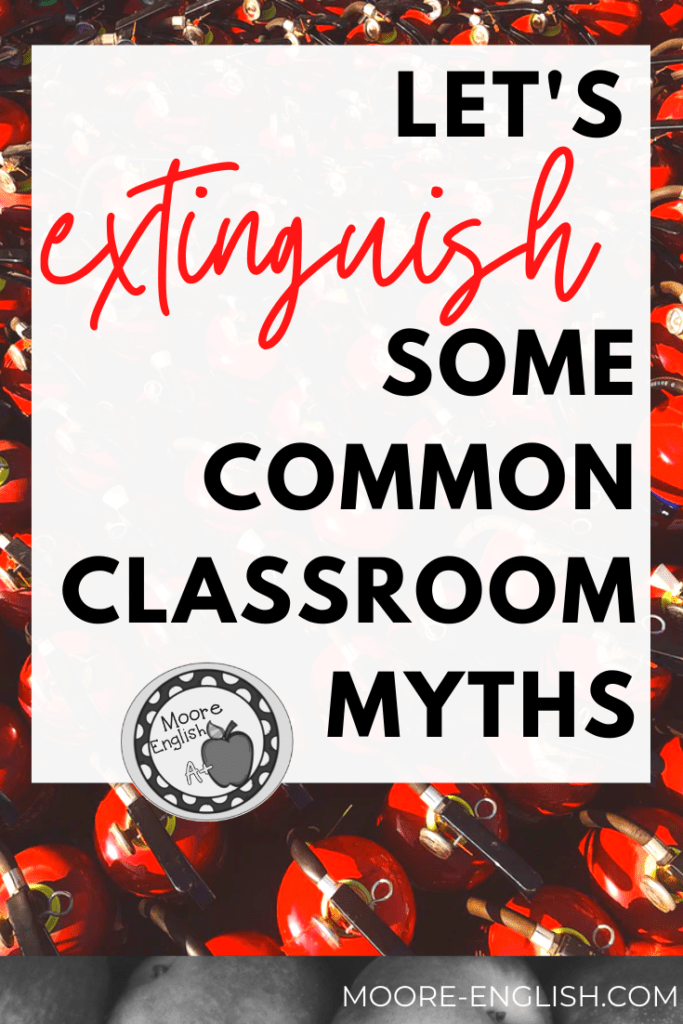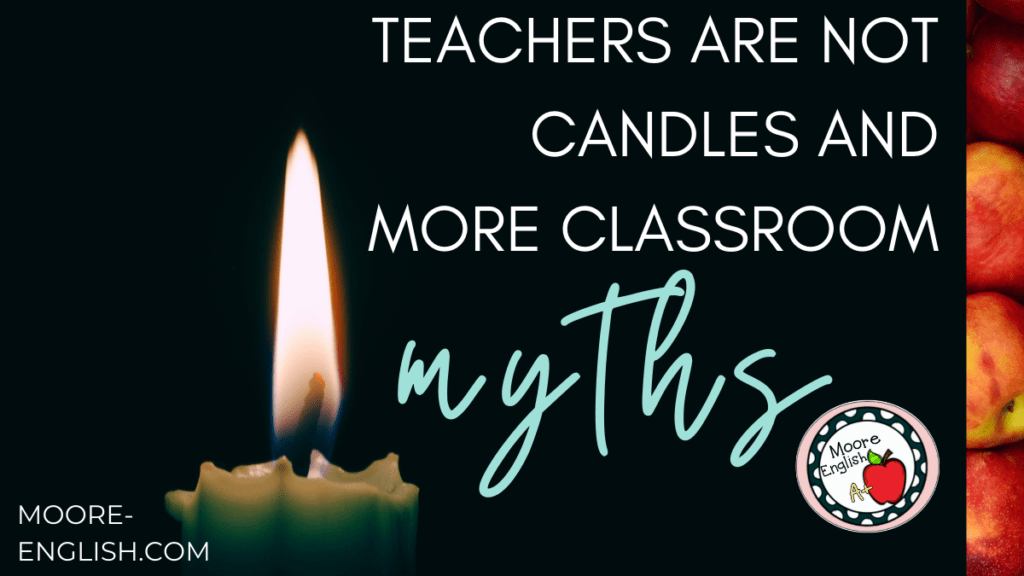Every so often, a quote appears on my Pinterest home feed: “A good teacher is like a candle – it consumes itself to light the way for others.”*
Each time I see this quote, I gnash my teeth because these supposed “words of wisdom” feed the notion that teachers are martyrs. Furthermore, this quote reinforces the idea that it’s good and right for teachers to live this way.
With this in mind, this week, we’re going to dispel the notion that teachers are martyrs and other common classroom myths.
This post this post may contain affiliate links. Please read the Terms of Use.
Classroom Myths: Teachers are not Martyrs
More than anything, this is a common classroom myth that we must dispel and reject. Teachers are professionals with collegiate credentials, ongoing professional development, and workweeks that are almost always more than 40 hours.
Unsurprisingly, teachers are more effective when we’re not exhausted. At a certain point, if we treat ourselves like candles or allow others to use us like candles, then there is nothing left, and we have nothing left to give. When that happens, how can we possibly hope to be beneficial to our students, colleagues, or communities?
Instead of burning the candle at both ends, teachers should have sustainable jobs and working conditions. Here are some popular posts and solutions for exhausted teachers:
- Confessions of a Recovering Teacher Martyr
- The No. 1 Greatest Lie about Teacher Self-Care
- What I Learned in a Year of Sustainable Teaching
- What I’m Keeping from My Year of Pandemic Teaching
- Anti-Resolutions: What We Can Give Up in the New Year
- 3 Ways to Find Peace of Mind When the World is in Pieces
Classroom Myth #2: Volume Determines Quality
I don’t know where this myth comes from, but it’s the belief that if a classroom is too loud or too quiet, then it must be a bad classroom.
Sometimes classrooms are loud. Students are moving through stations, having a classroom discussion, or working on a cooperative project. When this kind of learning happens, students learn through their actions and questions. In other words, there is productive chatter.
Other times, classrooms are quiet. Students are focused on silent discussion, choice reading, or journaling. When this kind of learning happens, students learn through silent struggle, by looking for answers within themselves. In other words, there is internal dialogue.
In both classrooms, learning is happening. And that’s all that matters. In other words, it’s a common classroom myth that a loud/quiet classroom is ideal. No, it’s what your students need in a lesson that determines success.
Classroom Myths #3: Worksheets Indicate Apathy
In college, I swore to never use worksheets in the classroom. Well, as with many of the things I swore in college, that was a short-sighted boast. Worksheets, like almost anything in the classroom, are a tool. When used in the right circumstances, worksheets have utility and can be meaningful. As with any instructional tool, worksheets can’t teach for you, and they can’t be the only means of delivery, but sometimes they are the right choice.
In my classroom, worksheets appear in a few different circumstances. Last week, my juniors used a worksheet to practice infinitives, and my sophomores used a worksheet to review author’s purpose. In both circumstances, a worksheet was the right tool because of the depth of learning my students needed and the time/resources available in a given day. Some other worksheets that my students use throughout the year include:
- Characterization Printables
- Introducing Literary Criticism
- Plot, Setting, and Conflict Printables
- Jane Austen Background Notes and Historical Context
- Quotation, Paraphrasing, and Summarizing Graphic Organizer
Classroom Myth #4: All Trends are Good
Education is full of trends. On one hand, trends can challenge or inspire us, fill gaps in our instruction, and push us out of our comfort zones.
But, like diet trends, not all classroom trends are good. Trends become the most dangerous when we spend so much time focused on being trendy that we lose sight of our students and their needs.
Similarly, trends are problematic when we assume that teachers not using a trend are bad or lazy. That is just not the case. I do a pretty good job keeping up with educational trends (here are recent round-ups of my current reading: 1, 2, 3, 4, 5). However, I don’t follow every trend about which I read. For one, that would be impossible, impractical, and expensive. Additionally, trends don’t always fit the needs of my students. In other words, following trends is not the measure of a successful teacher.
What classroom myths do you want to bust? Let us know below!


Photo by Dynamic Wang and Paul Hanaoka




















